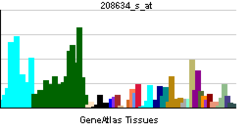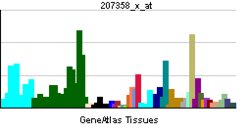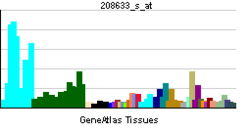- MACF1
-
Microtubule-actin cross-linking factor 1, isoforms 1/2/3/5 is a protein that in humans is encoded by the MACF1 gene.[1][2][3]
The protein encoded by this gene belongs to the plakin family of cytoskeletal linker proteins. This protein family forms bridges between different cytoskeletal elements through specialized modular domains. The encoded protein is one of the largest size proteins identified in human cytoskeletal proteins. It has functional actin and microtubule binding domains, and it appears to stabilize actin at sites where microtubules and microfilaments meet. It may function in microtubule dynamics to facilitate actin-microtubule interactions at the cell periphery and to couple the microtubule network to cellular junctions. Alternatively spliced transcript variants encoding distinct isoforms have been described.[3]
References
- ^ Byers TJ, Beggs AH, McNally EM, Kunkel LM (Sep 1995). "Novel actin crosslinker superfamily member identified by a two step degenerate PCR procedure". FEBS Lett 368 (3): 500–4. doi:10.1016/0014-5793(95)00722-L. PMID 7635207.
- ^ Okuda T, Matsuda S, Nakatsugawa S, Ichigotani Y, Iwahashi N, Takahashi M, Ishigaki T, Hamaguchi M (Dec 1999). "Molecular cloning of macrophin, a human homologue of Drosophila kakapo with a close structural similarity to plectin and dystrophin". Biochem Biophys Res Commun 264 (2): 568–74. doi:10.1006/bbrc.1999.1538. PMID 10529403.
- ^ a b "Entrez Gene: MACF1 microtubule-actin crosslinking factor 1". http://www.ncbi.nlm.nih.gov/sites/entrez?Db=gene&Cmd=ShowDetailView&TermToSearch=23499.
Further reading
- Nakajima D, Okazaki N, Yamakawa H et al. (2003). "Construction of expression-ready cDNA clones for KIAA genes: manual curation of 330 KIAA cDNA clones". DNA Res. 9 (3): 99–106. doi:10.1093/dnares/9.3.99. PMID 12168954.
- Caccamise DA (1978). "My franchise was a teen-age lion's den". Dental economics - oral hygiene 66 (11): 36–43. PMID 1074709.
- Seki N, Ohira M, Nagase T et al. (1998). "Characterization of cDNA clones in size-fractionated cDNA libraries from human brain". DNA Res. 4 (5): 345–9. doi:10.1093/dnares/4.5.345. PMID 9455484.
- Sun Y, Zhang J, Kraeft SK et al. (1999). "Molecular cloning and characterization of human trabeculin-alpha, a giant protein defining a new family of actin-binding proteins". J. Biol. Chem. 274 (47): 33522–30. doi:10.1074/jbc.274.47.33522. PMID 10559237.
- Nagase T, Ishikawa K, Kikuno R et al. (2000). "Prediction of the coding sequences of unidentified human genes. XV. The complete sequences of 100 new cDNA clones from brain which code for large proteins in vitro". DNA Res. 6 (5): 337–45. doi:10.1093/dnares/6.5.337. PMID 10574462.
- Leung CL, Sun D, Zheng M et al. (2000). "Microtubule actin cross-linking factor (MACF): a hybrid of dystonin and dystrophin that can interact with the actin and microtubule cytoskeletons". J. Cell Biol. 147 (6): 1275–86. doi:10.1083/jcb.147.6.1275. PMC 2168091. PMID 10601340. http://www.pubmedcentral.nih.gov/articlerender.fcgi?tool=pmcentrez&artid=2168091.
- Karakesisoglou I, Yang Y, Fuchs E (2000). "An epidermal plakin that integrates actin and microtubule networks at cellular junctions". J. Cell Biol. 149 (1): 195–208. doi:10.1083/jcb.149.1.195. PMC 2175090. PMID 10747097. http://www.pubmedcentral.nih.gov/articlerender.fcgi?tool=pmcentrez&artid=2175090.
- Sun D, Leung CL, Liem RK (2001). "Characterization of the microtubule binding domain of microtubule actin crosslinking factor (MACF): identification of a novel group of microtubule associated proteins". J. Cell. Sci. 114 (Pt 1): 161–172. PMID 11112700.
- Gong TW, Besirli CG, Lomax MI (2002). "MACF1 gene structure: a hybrid of plectin and dystrophin". Mamm. Genome 12 (11): 852–61. doi:10.1007/s00335-001-3037-3. PMID 11845288.
- Nakayama M, Kikuno R, Ohara O (2003). "Protein-protein interactions between large proteins: two-hybrid screening using a functionally classified library composed of long cDNAs". Genome Res. 12 (11): 1773–84. doi:10.1101/gr.406902. PMC 187542. PMID 12421765. http://www.pubmedcentral.nih.gov/articlerender.fcgi?tool=pmcentrez&artid=187542.
- Strausberg RL, Feingold EA, Grouse LH et al. (2003). "Generation and initial analysis of more than 15,000 full-length human and mouse cDNA sequences". Proc. Natl. Acad. Sci. U.S.A. 99 (26): 16899–903. doi:10.1073/pnas.242603899. PMC 139241. PMID 12477932. http://www.pubmedcentral.nih.gov/articlerender.fcgi?tool=pmcentrez&artid=139241.
- Kodama A, Karakesisoglou I, Wong E et al. (2004). "ACF7: an essential integrator of microtubule dynamics". Cell 115 (3): 343–54. doi:10.1016/S0092-8674(03)00813-4. PMID 14636561.
- Ota T, Suzuki Y, Nishikawa T et al. (2004). "Complete sequencing and characterization of 21,243 full-length human cDNAs". Nat. Genet. 36 (1): 40–5. doi:10.1038/ng1285. PMID 14702039.
- Colland F, Jacq X, Trouplin V et al. (2004). "Functional proteomics mapping of a human signaling pathway". Genome Res. 14 (7): 1324–32. doi:10.1101/gr.2334104. PMC 442148. PMID 15231748. http://www.pubmedcentral.nih.gov/articlerender.fcgi?tool=pmcentrez&artid=442148.
- Kakinuma T, Ichikawa H, Tsukada Y et al. (2004). "Interaction between p230 and MACF1 is associated with transport of a glycosyl phosphatidyl inositol-anchored protein from the Golgi to the cell periphery". Exp. Cell Res. 298 (2): 388–98. doi:10.1016/j.yexcr.2004.04.047. PMID 15265687.
- Lin CM, Chen HJ, Leung CL et al. (2006). "Microtubule actin crosslinking factor 1b: a novel plakin that localizes to the Golgi complex". J. Cell. Sci. 118 (Pt 16): 3727–38. doi:10.1242/jcs.02510. PMID 16076900.
- Gevaert K, Staes A, Van Damme J et al. (2006). "Global phosphoproteome analysis on human HepG2 hepatocytes using reversed-phase diagonal LC". Proteomics 5 (14): 3589–99. doi:10.1002/pmic.200401217. PMID 16097034.
Categories:- Human proteins
- Chromosome 1 gene stubs
Wikimedia Foundation. 2010.



